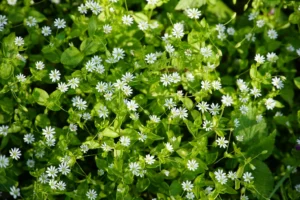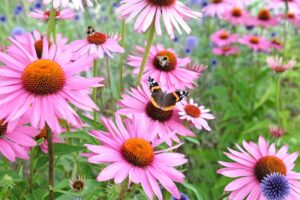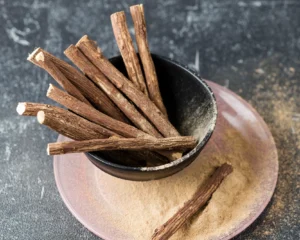Horehound

The overall appearance of horehound is distinctive and somewhat rugged, making it a notable herb in both culinary and medicinal applications. With its square stems, woolly leaves, and small, white or pale purple flowers, horehound adds a unique touch to gardens and herbal collections. The herb is valued not only for its appearance but also for its long-standing use in traditional medicine.
Size:
Horehound plants typically grow to a height of 1 to 3 feet (30 to 90 cm). The flowers themselves are small, ranging from 0.5 to 1 inch (1.3 to 2.5 cm) in diameter, and are arranged in clusters.
Color:
The flowers of horehound are usually white or pale purple. The leaves are green with a grayish or silver hue due to their fine hairs, giving the plant a somewhat dusty appearance.
Leaves:
The leaves of horehound are ovate to heart-shaped, with a woolly, hairy texture that feels rough to the touch. They are often aromatic and can have a slightly bitter taste, contributing to the herb’s distinctive flavor profile.
Flowers:
The flowers are small and tubular, clustered in the axils of the leaves. They have a subtle, delicate appearance and are less conspicuous compared to the plant’s foliage.
Fragrance:
Horehound has a strong, aromatic scent that is both herbal and slightly minty. The fragrance can be described as pungent and invigorating, which is characteristic of many medicinal herbs.
Blooming Season:
Horehound typically blooms in mid-summer, with its flowering period extending from July to August. The bloom period contributes to the herb’s overall appeal in gardens and herbal collections.
Habitat:
Horehound thrives in temperate climates with well-drained soil and ample sunlight. It is commonly found in gardens and wild areas across Europe, North America, and parts of Asia. The plant is adaptable and can tolerate a range of soil conditions.
Cultural Significance:
Horehound has been used in traditional medicine for centuries, particularly in European herbalism. It is often associated with remedies for respiratory and digestive issues. In folk medicine, horehound is celebrated for its role in supporting health and well-being, and it remains a valued herb in various natural and holistic health practices.
Spiritual Properties
- Purification and Cleansing: Horehound is believed to have purifying qualities, often used in spiritual practices to cleanse the aura and promote mental clarity.
- Healing Rituals: It is used in healing rituals to support recovery from illness and restore balance to the body and mind.
- Protection: The herb is thought to offer protective properties, shielding individuals from negative energies and promoting overall well-being.
Medicinal Properties
- Respiratory Health: Horehound is commonly used to treat respiratory issues such as coughs, bronchitis, and sore throats. Its expectorant properties help clear mucus from the airways.
- Digestive Aid: It assists with digestion and alleviates symptoms like indigestion, bloating, and gas.
- Anti-inflammatory: The herb has anti-inflammatory effects that can help reduce inflammation and provide relief from conditions like arthritis.
- Antimicrobial: Horehound has antimicrobial properties that help combat infections and support immune function.
Adverse Actions & Side Effects
- Gastrointestinal Issues: Horehound may cause digestive upset in some individuals, including nausea, vomiting, or stomach pain, especially when consumed in large amounts.
- Allergic Reactions: Some people may experience allergic reactions to horehound, such as skin rashes, itching, or swelling. It is important to discontinue use if any adverse reactions occur.
- Interaction with Medications: Horehound may interact with certain medications, such as blood thinners or medications for blood pressure. Consult a healthcare provider before using horehound if you are on medication.
Side Effects
- Headaches: Some users may experience headaches or dizziness when using horehound, particularly if taken in high doses.
- Dry Mouth: Horehound may cause dry mouth or throat, which can be uncomfortable for some individuals.
- Skin Irritation: Direct contact with horehound can cause skin irritation in sensitive individuals, leading to redness or rash.

Chickweed
Chickweed Chickweed is a small, delicate annual herb that thrives in cool, moist environments. It is commonly found in gardens, lawns, and meadows, often considered

Lemon Balm & Sage Healing Tea
Lemon Balm & Sage Healing Tea An ancient blend that supports emotional healing and provides mental clarity during times of uncertainty and confusion. Ingredients: Lemon

Jiaogulan
Jiaogulan Jiaogulan, often referred to as "Southern Ginseng" or "Herb of Immortality," is a climbing vine native to Southern China and other parts of Asia.

Echinacea Purpurea Leaf
Echinacea Purpurea Leaf Echinacea Purpurea Leaf is a well-known herb valued for its immune-boosting properties and use in traditional medicine. It is commonly used to

Licorice Root
Licorice Root Licorice Root is a perennial herb renowned for its sweet flavor and numerous health benefits. It has been used in traditional medicine for

Guggul Gum Resin
Guggul Gum Resin Guggul gum resin, derived from the Commiphora mukul tree, has a distinctive appearance. It is typically found in irregular, small to medium-sized